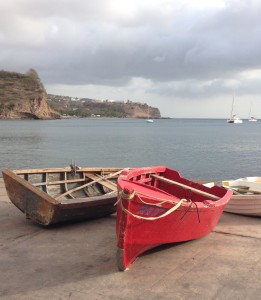Monserrat impresses. In fact, it leaves you speechless. This is something rare for Moss. And I didn’t write a word the whole time we were there. I think neither of us knew where to start; seeing the aftermath of an immense natural disaster is an experience that is not an easy thing to process.
We anchored in the only place you can, a harbour called Little Bay. Visitors are limited to this one anchorage because half of this island was wiped away by the active Soufriere Hills volcano in the 1990s.
This disaster destroyed the capital, Plymouth, as well as the airport and almost all docking facilities. Two thirds of the population were forced to flee. The remaining population is now slowly rebuilding their nation’s infrastructure in the northern section near Little Bay. There is no real support for cruisers and certainly no chandlers for boat parts. And we needed parts.
The crossing to Monserrat had been our roughest one yet. The conditions weren’t particularly bad (wind 20-25 knots, waves 1-2m, with the occasional 3m), but it was enough to snap one of the support braces for the bimini.
The support was one we had added ourselves, connecting the bimini to the radar arch. The intention was to add stability. We think the bimini just bounced around too much in the crossing and the support snapped.
It’s okay. Things break on a boat.
One of the metal eyes on the boom that hold the main sheet also broke when the sheet was pulled too tightly. This was our own doing. Our growing crew sometimes don’t know their own strength.
It’s okay. Things break on a boat.
Shortly after anchoring in Little Bay, I went below and noticed water on the forward cabin floor. This seemed odd, but the crossing had been a bit rough, which could explain it. My only thought was to clean it up. But then I noticed water pouring in from the bottom of the forward starboard head door.
Hesitation — images of a room full of water, complete with fish swimming around, came to mind. I called at Moss and opened the door to find a foot of water in the head. Lots of noise (from me) ensued, and Moss discovered that the sink through-hull had broken clean off, and sea water was pouring in. Our first real emergency.
It’s okay. Things break on a boat.
Moss stopped the flow of water immediately with a soft wood through-hull plug. And a big bilge pump out and clean up followed. There was no real damage, just a big wet mess everywhere, as the water had tipped over a garbage bin.
We weren’t sure if the soft wood plug would hold for the next island hop, so our main Monserrat goal changed from visiting to volcano site to locating a ball valve to block the sink through-hull.
Did I mention Montserrat is half destroyed? And that there are no chandleries or marine supplies anywhere?
Someone at Customs and Immigration referred us to the Montserrat Yachting Association for assistance. This fledgling organization has an exclusive membership count of one (at the time of writing), but bearing in mind Montserrat has a population of only about 4000 people, that’s not bad. And what the association lacks in quantity, it makes up for in quality.
Serge, the President (and only member) really came through for us. He took time away from his work and personally drove us to a car mechanic’s workshop (who wasn’t there), and to two different hardware stores in our quest for a ball valve. And we found one! And the man who sold it to us is was the brother of the president of Monserrat. So now we feel all connected. As mentioned, it’s a small island.
Thank you, Serge!
We were also able to “fix” the other two issues as well. We used line (i.e. rope) to lash the bimini to its support. And we “replaced” the main sheet eye with line too, looping it through as many times as would fit. (And it’s still holding! Un grand merci à Mario from Allego!)
With our repairs done (as much as they would be), we then were able to turn our attention to the volcano.

